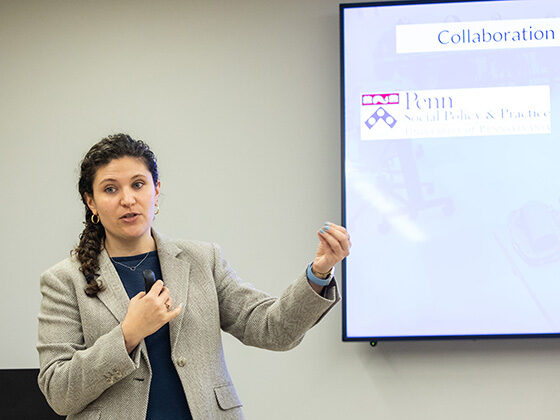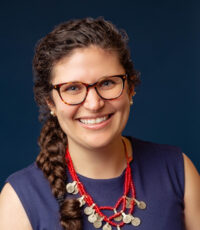News Details
Working to understand & prevent intimate partner violence: A Q&A with Assistant Professor Millan AbiNader

Authored by: Carson Easterly
Faculty & Research
09/14/23
A long-time advocate for survivors of gender-based violence, Millan AbiNader, MSW, PhD, is a mixed-methods researcher and macro social worker who seeks to understand how systems and communities affect individuals’ experiences of gender-based violence. AbiNader began working as a victim services advocate as a college student and aims to stay connected to those roots as she leads research that supports survivor healing and perpetrator change.
You’re finishing up your second year on the faculty of Penn’s School of Social Policy & Practice (SP2). What initially drew you to SP2?
I’m a macro social worker, which means I am interested in systems and policies and the running of programs and institutions. While a lot of schools of social work are very clinical, SP2 and Penn offered an opportunity to be in an interdisciplinary space that considers macro-level factors.
The problems I look at are not simple; they are not siloed. You need an interdisciplinary approach to respond to them — for instance, social workers, doctors, and nurses working together when someone comes into the hospital with an injury due to intimate partner violence, or social workers and legal experts collaborating to create legislation that protects survivors from violence. It’s exciting to be at a school and a university that not only have an interdisciplinary focus, but also have the resources and networks to really back that up. And I’m from Philadelphia! It was exciting to come home and be back in this great city.
What drew you to your research focus on gender-based violence (GBV) and intimate partner violence (IPV)?
I’ve been working with survivors since I was 18. This field of work has shaped my entire adulthood; it has shaped who I am. I started working with a community organization in my town when I was an undergraduate at Bowdoin College. After I graduated, I went on to work full-time for a domestic violence agency in the community called Through These Doors, where I worked with women who were incarcerated and were survivors of intimate partner violence, family violence, sexual violence, and/or trafficking.
When I was working with survivors, particularly the survivors who were incarcerated, I watched people try to heal and change their lives, and I watched their partners also try to do the same. But they experienced barriers that had nothing to do with how hard they were trying, or the great work that they were doing to heal. There was system, after system, after system making things harder for them. I wanted to go back to school to better understand systems and institutions so that I could develop new ways for them to support people’s abilities to heal and change. That’s why I’m a macro social worker.
I earned my MSSW at the University of Texas at Austin. Throughout my PhD program in social work at Boston University, I continued to do grant management and program evaluation work with agencies that respond to violence, in addition to facilitating groups in prison and trauma-informed yoga as part of substance abuse treatment.
Can you speak more about the different kinds of systems that are creating barriers for people to find healing and change?
All forms of systemic oppression — poverty, racism, ableism, sexism — all of those trickle down into our institutions and make it very hard for people to progress. We know that people of color, male victims, trans victims, LGBTQ victims, and others with minoritized identities are often less believed in our legal and health systems. Oppression is a large macro factor that’s affecting people.
Policies can be another barrier. For example, the criteria for obtaining a protection order may exclude individuals who do not fit traditional definitions of an intimate partner.
If it must be someone who you are married to, have children with, or who you have lived with, then there’s a whole group of people who are experiencing violence in their relationships who don’t have access to those protective orders. Also, the reauthorization of VAWA, the Violence Against Women Act, determines the availability of funding for agencies across the country to carry out this work.
Child welfare involvement often poses additional challenges. For victims seeking to regain parental rights, having an abusive partner is often counted against them, even though it is the other parent creating violence in the home. When I was working in Maine, for example, every child over the age of five needed their own room. If you’re struggling economically, it’s really hard to find a four-bedroom apartment for you and your kids. That’s a policy that, if it were just shifted a little bit, would increase the ability of a lot of parents to secure a safe home away from the perpetrator parent.
Barriers also include whether hospitals are screening for IPV, what happens when they screen, and how that question is asked. Many of us have been asked, “Do you feel safe at home?” by a doctor at some point. Asking the question in the same tone as routine health inquiries may deter victims from confiding in health care professionals when they need help.
How are you working to improve systems’ responses to GBV and IPV through your research?
My current work primarily focuses on fatalities — suicides and homicides — that occur in the context of IPV. Fatalities offer us a roadmap to understand how we can better improve the systems that can help de-escalate violence before it reaches lethality and help both perpetrators and victims before violence turns fatal.
In most of these cases, whether it’s a suicide or a homicide, there was a history of IPV ahead of time, and in some cases, there were prior interactions with systems, but something about those interactions didn’t work or the opportunity for intervention was missed completely.
In my work on IPV-related suicides, what we’re seeing in our research so far is that a majority of these cases are IPV perpetrators. It’s important to think about fatality as not only a risk to victims, and part of my current work involves exploring non-traditional interventions for perpetrators.
The Survivor Link + Public Health AmeriCorps program, which you and the Field Office manage at SP2, just received its second year of funding. The program provides financial support for SP2 students to join a cohort of over 100 social work students from across the country engaging in AmeriCorps service. Can you tell us more about this initiative and its impact?
The Survivor Link program started at Arizona State University and then expanded nationwide. Our goal is for students to go into community-based agencies and help increase their capacity to appropriately respond to survivors of IPV. This year, we’ve expanded from three to five second-year MSW students. The students are prepared to deliver three domestic violence trainings at their field placements to clinicians, administrative staff, and others.
This is important because many social workers do not receive comprehensive training on this topic when they’re in school unless they specifically take a gender-based violence or domestic violence class.
Through our students, social workers at the agencies also gain deeper training on IPV. Almost one in two women in the United States experience IPV, so it’s crucial that social work students and practitioners have this training. They will undoubtedly interact with clients who experience or have experienced intimate partner violence.
Another way that you work with students outside of the classroom is your Gender-Based Violence Research Group (GBVRG). Can you tell us more about the team’s work?
Since we’ve started, I’ve had eleven students come through the lab and work with me on different projects. Students have been reading case files of homicides and collecting data on the relationship histories and helping with background work for some papers I have in progress about GBV. Last year, a student helped me develop and deliver a program on vicarious trauma for domestic violence victim services advocates in rural Botswana. This year, students will start reading case files of suicides and abstracting that data so we can understand more about what’s happening in those relationships prior to the fatality.
The GBVRG is also participating in a national homicide research project called the PAIR (Preventing and Assessing Intimate Partner Homicide Risk) study. What does the group’s involvement with the study look like?
The study is collecting data on IPV-related homicides over a five-year period in three pairs of states. States within each pair have very different firearm laws and demographics. We are comparing the relationship histories of homicide cases to those of a control group — people who have experienced the risk factor of physical violence in their relationship but have not died.
At Penn, a lot of our work is looking specifically at the impact of COVID-19 and related policies in New Jersey and Arizona. The two states had distinct experiences with the disease and had implemented different policy responses. We are looking to see if there are any variations in homicide rates due to these differences in policies.
SP2 faculty members each teach across multiple degree programs. What are some highlights of your work in the classroom?
I teach Human Behavior in the Social Environment in our Master of Social Work (MSW) program. I really love teaching that class because it’s all about how we take big theoretical ideas and apply them to real-life situations. It delves into questions like: What would you actually do in the field with social learning theory and cognitive theories? How would you apply that to a community or a person sitting in front of you? It’s also really fun to be the first face that the social work students see. I teach Tuesdays at 8:30 every year, so I’m literally their first class of the semester.
I also teach a criminal justice policy class in the Master of Science in Social Policy (MSSP) sequence. We go through the different steps someone might encounter in the criminal legal system, from arrest to reintegration back into the community, and talk about relevant policies at each step.
This year, I’m developing a course on gender-based violence, which will be open to all master’s level programs in our school. I’m hoping it will be really interactive. Each student will become an expert in gender-based violence in a particular population or region around the world and look at different forms of violence over the course of the semester.
How would you describe the values that guide your approach to this work?
For GBVRG, we came together as a team to determine a list of values to guide our social media presence and our work together. Our list included intersectional feminism, attention to oppressive social structures, anti-violence, equity, being survivor-centered, and being trauma-informed.
One of the most important things about my work is that it stays grounded in my practice experience and the lived experiences of the people who are involved in IPV and GBV more broadly. I try to make connections with local agencies that are doing this work, seeking input and ensuring my efforts align with the realities of advocates and survivors.
Practice experience and connection to community organizations are both really important to me, but I also think it’s what makes social work, social work. We’re not just trying to create knowledge for knowledge’s sake; we’re asking questions that are relevant to communities, creating answers that work in communities, and supporting communities as they implement these strategies.
